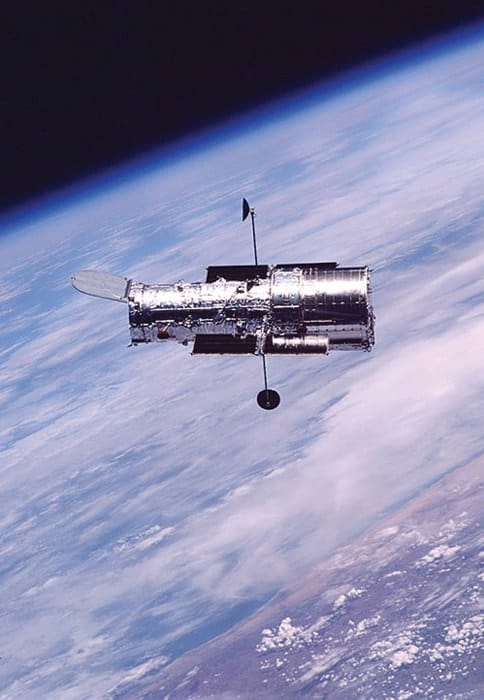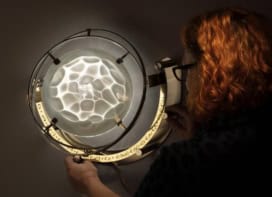Gravity thrills, Particle Fever intrigues and Hawking proves surprisingly insightful – physics film reviews by Margaret Harris and Andrew Williams
The right stuff

Physics World is arguably a little late to join the critical love-fest for Gravity. Alfonso Cuarón’s space-adventure film opened in the US in October 2013 and, despite achieving considerable box-office success on both sides of the Atlantic, its days in cinemas may well be numbered by the time this review is published. But if it is still showing in your area, and you haven’t yet seen it, take our better-late-than-never advice: go. In fact, go now. You can read the rest of this review later (it’s got spoilers anyway). As the film opens, its stars – Sandra Bullock as a scientist and first-time astronaut; George Clooney as an old-school space veteran – are performing a spacewalk as they carry out a routine upgrade to the Hubble Space Telescope. But after the briefest of introductory scenes, Houston informs them that they have a problem: a huge cloud of debris from a failed Russian satellite is hurtling towards them, punching holes in everything in its path. What follows is essentially an astronaut’s vision of hell, as Bullock’s character – cut adrift from her damaged shuttle and out of contact with Mission Control – struggles through fire, water and a pitiless shortage of air in her efforts to return to Earth. The special effects required to create such sequences are impressive but not perfect, and for many physicist viewers, part of the fun will come from spotting moments when astronauts or pieces of debris behave in unphysical ways. But we suggest saving such analysis for a second viewing. What makes Cuarón’s film great is not just its special effects, but the way he and the actors use sparse dialogue and a bleak, expansive setting to create a curiously intimate-seeming film. Bullock, in particular, is fantastic in her role as a scientific everywoman, and while it is hard to believe that the real-life NASA would send an astronaut into space who had crashed the Soyuz simulator every time, her personal journey is realistic and never overdone.
- 2013 Esperanto Filmoj/Heyday Films/Warner Bros, http://gravitymovie.warnerbros.com
Inside the LHC
Particle Fever, a new documentary film by Mark Levinson and the theoretical physicist David Kaplan, lifts the lid on the inner workings of CERN as scientists there wrestle with the twin challenges of installing and running the Large Hadron Collider and using it to search for the Higgs boson. From a purely educational perspective, professional physicists are unlikely to learn much from this film about the theoretical and experimental science that underpins the work at CERN. However, the film does work well as a layman’s introduction to concepts such as multiverse theory, supersymmetry, the Standard Model and the cosmological constant – largely as a result of the deft use of smooth graphics, coupled with clear and concise explanations from the scientists involved and jaw-dropping footage of the collider itself. But education was never the main point of a film that, above all else, is most successful as a sometimes revealing portrait of the working lives of the men and women caught in the glare of the global media spotlight. By following the inside story of six scientists – including Fabiola Gianotti and Savas Dimopoulos as well as Kaplan himself – it also provides a unique insight into the dogged tenacity required to endure the triumphs and disappointments involved in such large-scale and high-publicity experiments. As Dimopoulos says, in particle physics “jumping from failure to failure with undiminished enthusiasm is the big secret to success”.
- 2013 Anthos Media, http://particlefever.com
Hawking on film
Great books often get made into mediocre films, but every so often, the reverse is true. Such is the case with Hawking, a candid biopic of the University of Cambridge cosmologist that stands head and shoulders above its subject’s own recently published memoir (“In search of the real Stephen Hawking”). Hawking is credited as one of the film’s writers (the others are Ben Bowie and director Stephen Finnegan), and he provides much of its narration. Crucially, though, we also see footage from interviews with his sister Mary, his friends, students, nurses and even his ex-wife Jane. Their reminiscences combine to give us a much more complete picture of Hawking’s life and personality, and the camera’s sympathetic eye sees much that would be difficult to get across in words. It is one thing to read in Hawking’s memoir that his first electric wheelchair “gave [him] a considerable degree of independence”, but it is quite another to watch footage of him chasing his young son around the garden in it. It is also interesting to hear Peter Guzzardi, who edited Hawking’s bestselling popular book A Brief History of Time, say that he was “really disappointed” with its first draft. The fact that Hawking was both determined and willing to completely rewrite it – despite being interrupted by a major health crisis – says much about the man whom his friend and colleague Kip Thorne calls “the most stubborn person I’ve ever met”.
- 2013 Vertigo Films, www.hawkingfilm.com



